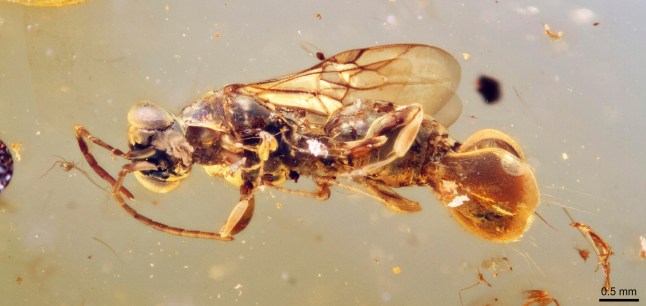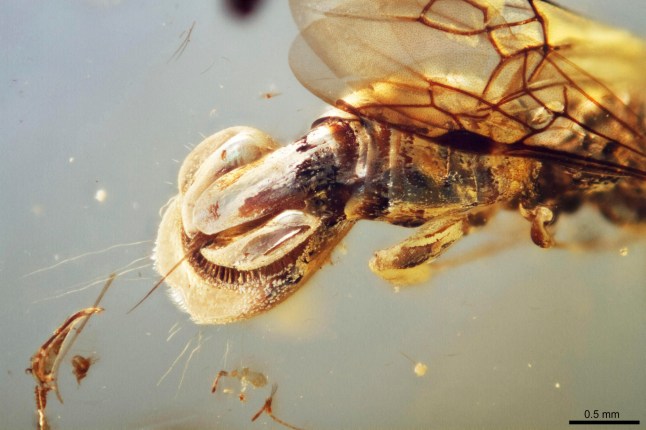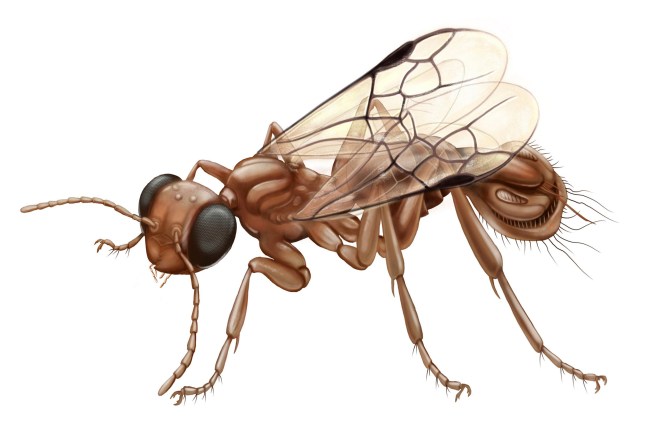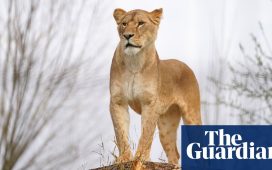A newly identified wasp that buzzed among the dinosaurs had a bit of a unique way of catching prey.
Researchers studied 16 wasps frozen in 99-million-year-old Kachin amber in northern Myanmar, research published Thursday saidf.
But while the first half of these ancient insects could easily be mistaken for a modern wasp, the bottom half caught the palaeontologists off guard.
Meet Sirenobethylus charybdis, a wasp that the team half-jokingly called a ‘Cretaceous flytrap’ for its rear being shaped like the fly-gobbling plant.
‘Nothing similar is known from any other insect,’ the researchers wrote in the journal BMC Biology.
Lars Vilhelmsen, co-author of the study from the Natural History Museum of Denmark, said the wasp has a ‘small bear trap attached to the end of it’.

‘When I looked at the first specimen, I noticed this expansion at the tip of the abdomen, and I thought this must be an air bubble,’ Vilhelmsen added.
‘It’s quite often you see air bubbles around specimens in amber. But then I looked at a few more specimens and then went back to the first one. This was actually part of the animal.’
But rather than devouring creatures like a Venus flytrap, the team suspect that the wasp used its rump, lined with bristled hairs, to restrain prey.
Trapped in its bum flaps, the struggling insects would likely be unable to do anything as the prehistoric predator injects an egg inside it.
Over time, the egg would hatch inside, with the wasp larvae nibbling on it from the inside.
Scientists say they realised this after spotting that the wasp’s ovipositor, its egg-laying organ, is tucked between the maws.

The abdomen may also have been used to hold onto a mate – we guess it had a strong fear of being rejected.
Vilhelmsen and his colleagues from Capital Normal University in Beijing realised that the appendage could wiggle around as it was in different positions across all the specimens.
‘Sometimes the lower flap, as we call it, is open, and sometimes it’s closed,’ he explained.
‘It was clearly a movable structure and something that was used to grasp something.’
If this is the case, sirenobethylus charybdis may have written the playbook that cuckoo wasps follow today.
Named after the wily cuckoo bird, these emerald-coloured critters lay their eggs in other wasps’ nests, so their young can feast on their new host’s larvae.

Amber has long been a vessel for prehistoric remnants, with everything from ancient plant ‘blood’ and lice to even crabs being found inside them.
The gem forms over millions of years as tree resin fossilises.
The authors said a fossil enthusiast purchased the amber containing Sirenobethylus charybdis and donated it to Capital Normal University’s Key Laboratory of Insect Evolution and Environmental Changes in 2016.
‘This is something unique, something I never expected to see, and something I couldn’t even imagine would be found,’ Vilhelmsen added.
‘It’s a 10 out of 10.’
Get in touch with our news team by emailing us at webnews@metro.co.uk.
For more stories like this, check our news page.
MORE: Golf club branded ‘inhumane’ after admitting ‘unauthorised’ fox shootings on its course
MORE: Crocodile kills beachgoer and swims through sea carrying victim in its jaws
MORE: Myanmar earthquake death toll rises to over 1,640 with dozens missing in Bangkok














